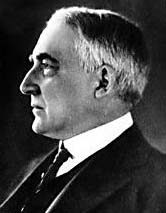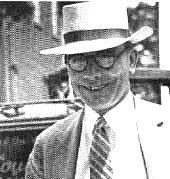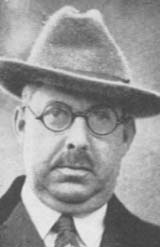
Historical Tales | News | Vampires | Zombies | Werewolves
Virtual Academy | Weapons | Links | Forum
Famous Cases: Who Killed Warren Harding?
Report Number: 2381*
*As the actual file is missing, this case has been pieced together from interviews, memoirs and assorted public records.
Date: August 2, 1923
Location: San Francisco, California
Of all the American presidents who died in office, none has more questions surrounding his demise than the 29th President, Warren Harding. After Harding expired in San Francisco on August 2, 1923, the cause of death was ascribed to food poisoning, a determination later changed to stroke. However, many people suspected murder, as Harding had his share of enemies. But the true story behind Harding's death may have gone to the grave with one dogged FVZA Agent.
 |
| President Harding |
Shortly before he left, the President received information that someone in the Justice Department was receiving kickbacks from Chicago gangster Al Capone's organization in order to protect Capone's monopoly on bootlegging (the United States had been "dry" since Prohibition began in 1919). Harding discussed the matter with Jess Smith, and both men endeavored to launch a full investigation when they returned to Washington.
Harding's historic trip west was beset by problems. A ship taking the President up the Alaska coast ran aground, then the President became sick with food poisoning after dining on some local crabs. On July 30, 1923, as the ship set sail from Alaska to San Francisco for the last leg of the trip, President Harding was eager to get back to Washington and commence a new, corruption-free chapter in his presidency.
 |
| Franklin Prevost |
Both Smith and Florence Harding wanted to keep the true means of the President's demise a secret. Prevost was hesitant, but eventually agreed to keep quiet and so, on August 2, 1923, it was announced that President Harding had died of food poisoning while on his way to San Francisco. No further investigation was ever conducted, as Florence Harding would not allow an autopsy on her husband. The body was returned to Washington for burial, and for the first and only time in American history, an FVZA report was suppressed.
 |
| President Harding's Funeral |
Investigation: The rumors and suspicions eventually died down as Vermonter Calvin Coolidge assumed the reins of government. But across the country in San Francisco, several unanswered questions continued to nag at FVZA Director Prevost. How had a man bitten by a vampire been able to board a ship carrying the President? And how had that vampire gotten to Harding, who was under full Secret Service protection?
 |
| Capone hit men Scalise and Anselmi |
Then came a stunning announcement from Washington: former Assistant Attorney General Jess Smith had been indicted for accepting bribes from Al Capone. For Prevost, Smith's link to Capone seemed to solve the puzzle of Harding's death. During the trip west, Smith had enjoyed unfettered access to the President, and stood to lose much in Harding's promised purge of corruption. In addition, as assistant head of the Justice Department, Smith had access to the FVZA lab, from which several vials of vampire blood had gone missing shortly before President Harding's trip west. Prevost told FVZA Director Hilton Dickerson of his findings; Dickerson summoned him to Washington, and told to bring along his report.
Prevost left San Francisco for Washington on September 12, 1924, but he never reached his destination. As he stepped off the train in St. Louis, two men with tommy guns burst into the station and opened fire. Prevost was shot 12 times, and died a short time later at a nearby hospital. His report was never recovered.
 |
| Jess Smith: Assassin? |
Post-Mortems: Although Prevost's file was gone, he left behind enough information in his San Francisco office to build a case against Jess Smith in the death of Harding. FVZA Director Hilton Dickerson had every intention of pursuing the case, until Smith himself wound up dead from an apparently self-inflicted gunshot wound (the gun was found in his right hand, but the bullet wound was in his left temple). Smith's death meant that, only two years after Harding's death, virtually everyone involved in the event was gone (Florence Harding died November 21, 1924). Only Al Capone remained, and he wasn't talking. The Harding assassination case was dropped, and Capone continued to prosper until he was jailed for tax evasion in 1931. Afflicted with syphilis, he died in Florida in 1947.
Comments from Dr. Pecos: Is it possible that Warren Harding's close friend and Assistant Attorney General Jess Smith arranged and helped carry out the murder of the President? The evidence is certainly compelling. Unfortunately, we will never know the truth, and Harding's cause of death is still officially listed as a stroke. For Franklin Prevost, a man accustomed to battling the undead, the fight against organized crime was played out under a different set of rules. Though he paid for it with his life, Franklin Prevost's courage stands as a proud chapter in FVZA history.